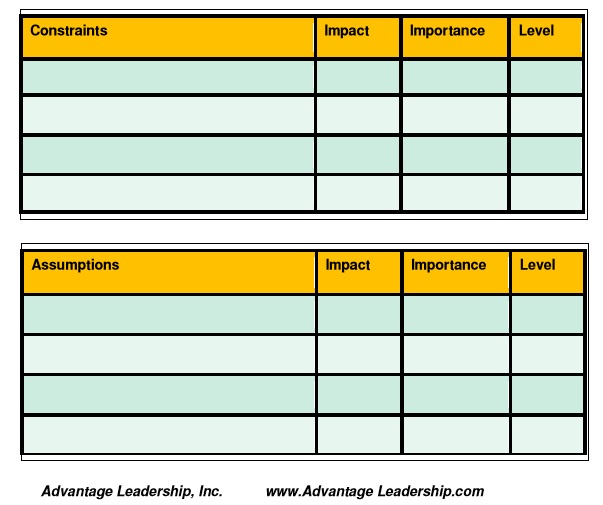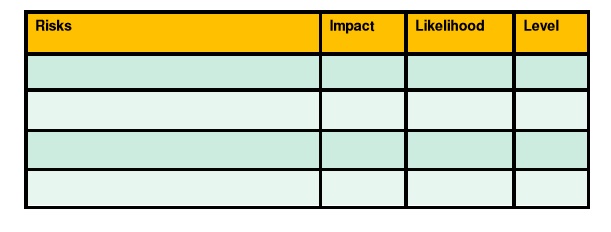December 13, 2016
Simple matrices can be very powerful tools to analyze constraints, assumptions, risks or other elements that must be addressed in your Project Plan.
Constraints and Assumptions:
- Brainstorm all constraints or assumptions for the project. If you are a one-person or very small team, recruit Subject Matter Experts, stakeholders or others who can help you create a more complete list.
- Give each item a rating for the Impact it would have on the project and the overall Importance it has for the project. Use a 5-point scale: 1 = very low - 5 = very high.
- Complete ratings for Impact and Importance for each item before you proceed to the next item. (If you go down the list rating the Impact of each item first then do the same for the Importance of every item, you will compare items to one another subjectively.)
- Multiply Impact X Importance = Level
- Now you have a ranked, prioritized list of constraints or assumptions.
- Establish your own Action Point, i.e., anything above 15 must have an Action Plan. Add specific tasks to your Plan to address the constraints or assumptions above the Action Point. Remember, the Action Point is arbitrary – a judgment call. You may need to change it as the project progresses.

Risk
Use the same approach for creating your project Risk Management Plan. However, you will use a different category for the analysis, Likelihood1.
- Brainstorm all risks for the project. If you are a one-person or very small team, recruit Subject Matter Experts, stakeholders or others who can help you create a more complete list.
- Give each item a rating for the Impact it would have on the project if it happens and the Likelihood it will happen. Use a 5-point scale: 1 = very low - 5 = very high.
- Complete the ratings for Impact and Likelihood for each item before you proceed to the next item. (If you go down the list and rate the Impact of each item first then do the same for the Likelihood of every item, you will compare the items to one another subjectively.)
- Multiply Impact X Likelihood = Level
- Now you have a ranked, prioritized list of Risks.
- Establish your own Action Point, i.e., anything above 15 must have an Action Plan. Add specific tasks to your Plan to address the risks above the Action Point. Remember, the Action Point is arbitrary – a judgment call. You may need to change it as the project progresses.
- For your actionable risks, create a Contingency Plan. Depending on the type of project, these may have to be quite elaborate and detailed.
- Determine, if you can, what an “early warning sign” of each actionable risk might be. Build close monitoring of these indicators into your Project Plan and watch closely.
- Create a Risk Management Plan (as part of your Project Plan) including the tasks to monitor the early warning signs and the Contingency Plans for the Action Point Items.

Full Risk Analysis
(These are some typical items people include in their analysis of each Risk. Develop your own list customized for your situation.)
Project Name
Risk ID #
Responsible person
Risk identification date
Risk Description
Early warning sign
Trigger event
Consequence/Impact description
Consequence/Impact value (quantify impact; (1-5)2
Rationale for Impact value
Likelihood value (quantify Likelihood; (1-5)3
Rationale for Likelihood value
Response Strategy
Known Cost of Response
Contingency for Response
WBS Relationship (tasks associated with condition or response strategy)
